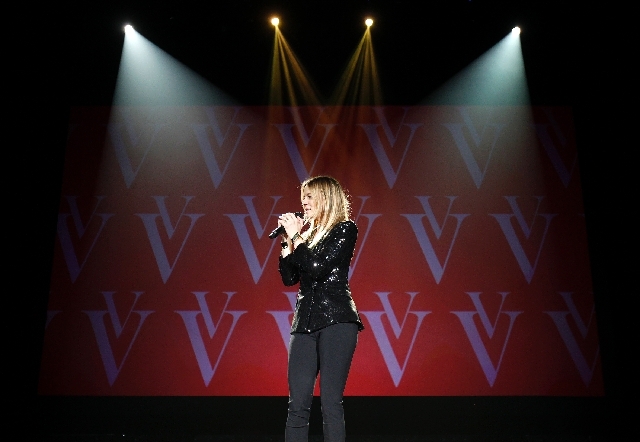Veronic DiCaire a great voice imitating great voices

Make no mistake. Veronic DiCaire is an amazing impressionist.
She imitates dozens of singers, many of them so dead on that when the occasional one doesn’t land, you’re willing to let it slide and skip to the next one.
If that’s all you need, you will be very happy here at this new Bally’s show.
Otherwise, you might find yourself asking questions better left unasked in many a Las Vegas production.
Why are we doing this?
What is the point of it?
The answer could be the usual Vegas crass: that it stands to make a lot of money.
DiCaire is a Canadian protege of Celine Dion and her manager-husband, Rene Angelil. French and Canadian audiences already responded in significant numbers.
Adapting the act to English-speaking audiences and parking it on the Strip — where DiCaire will be at least through Aug. 31 — makes sense if you believe the death of Danny Gans left a gaping void in entertainment that simply must be filled.
And a female impressionist can venture into a whole new realm of voices, without once trotting out a duet between Louis Armstrong and Kermit the Frog.
Having endured so much of that for so long, it’s a genuine thrill to hear DiCaire’s opening wallop. She slaps her cards on the table with powerful sound-alikes of Beyonce, Adele, Christina Aguilera and — why make ’em wait? — Celine.
But as the show goes on, something seems lost in translation.
Gans was, as Terry Fator is now, squarely in the tradition of the variety TV they grew up watching. Their essentially one-man shows created the illusion of more going on up there than just one impression after another.
Part of the good will Fator generates comes from his talk-show camaraderie with a live band. “Veronic: Voices” is sung to recorded tracks. Despite occasional help from six dancers, this sweet, likable woman often seems kind of alone on the big “Jubilee!” stage.
Combine the inflexibility of the tracks with patter that comes off very scripted for its English-as-a-second-language speaker, and “Voices” seems nailed- down and rigid.
But the real dividing line may come with how you feel about singing the songs as is, restraining any humor to the introductions.
DiCaire sings the late Amy Winehouse’s “Rehab” full-on, but sets it up by explaining how to do the imitation: Pretend you haven’t slept in three days, that your mouth is numb from the dentist and that you “balance a small poodle on your head.”
Comedy is usually what an impressionist brings to the table beyond rote mimicry. But I’m on her side with this one.
Face it, impressionist jokes are usually more bad than good. And DiCaire’s few exceptions to playing it straight — such as introducing a country segment in the guise of Dolly Parton — suggest we’re not missing out on any comedy gold by having her stay mostly on the path of good taste.
The showcase is solidly constructed with first-class lighting and rear-screen projections. It’s lumped into segments that create logical ways to group the voices — a tribute to the ’80s, or a really fun Top 40 salute with the dancers, pitting the likes of Lady Gaga, Katy Perry, Pink and Rihanna in mock competition.
It takes a great voice to imitate great voices. DiCaire doesn’t run from any of them, not even Barbra Streisand. She sings so well, you want to hear her real voice and learn more about her by the time she sits down at the piano to sing as Annie Lennox, Norah Jones and Alicia Keys, exploring “the connection between music and the emotion, so seamless.”
It’s a bittersweet, if pitch-perfect reminder of what those singers offer, and what this superficial skim of pop music history mostly does not.
Contact reporter Mike Weatherford at
mweatherford@reviewjournal.com or 702-383-0288.